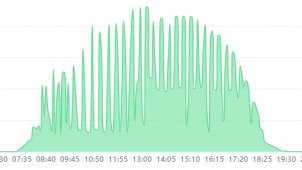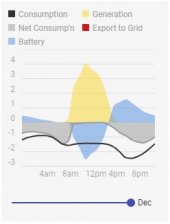OP has 24x12Vx120Ah AGM in Montana at 45 degrees latitude with "not very good" winter sun hours.
I doubt that the bottleneck in his setup is going to be the single Sol-Ark 15K....
I have a battery bank consisting of 24 12v 120ah AGM batteries series-parallel wired for 48v and 34,560wh total (17,280wh at 50% DOD // 8,640wh at 25% DOD). Will soon have the Aims PICOGLF10KW48V240VS 10,000w 48v split-phase inverter-charger. Using Outback Flexmax 80 charge controllers...

diysolarforum.com
Seems like they're putting lipstick on a pig... But hey, you do you...
I think my main problem (aka "lipstick on a pig') is two-fold.
1) I don't have a lot of knowledge in this field and am on a limited budget for what I am planning to accomplish (champagne tastes - beer budget). Therefore, I am constantly seeking information from whatever reliable sources I can find. This forum is one such source/resource. I don't mind investing the money and time for things that will work. I just can't afford to waste money/time needlessly.
2) As I learn more and as technology rapidly advances, I update my intentions of what I want to accomplish and how I would like to do it. The reason for this is that I am 63 years old, retired, and intend to build an off-grid system that will fulfill all of my needs and outlast me for quite a long time.
For example: My first system was 12v 4000w using a combination of solar and wind. I have upgraded it to 24v 6000w. This is the most power I can send through the size of wires that I have buried in the conduit to my RV hookup and apartment. Fortunately for me, the folks at Missouri Wind and Solar were able to update the 1600w generator and charge controller for the wind turbine. I rewired the 16 6v Trojan batteries [4s4p] and installed a new 24v/6000w Aims split phase inverter/charger. I made some programming adjustments to the two Outback Flexmax 80s and everything is running well. Besides the turbine, I have two strings of three Longi 360w bifacial panels and one string of six 100w panels. The 360w strings are going into the FM80s and the 100s are going into the charge controller for the turbine. This all keeps my 21.6kwh [10.8kwh @50% DOD] battery bank very happy and fully charged much of the time. However, in case of any problem, I do have a 10kw gas/propane generator that is rarely used.
Regarding my new system: As recently as a year ago, I considered going with a 10kw Aims inverter. This was going to be for the shop only. Then, it was suggested to me that I could use a single (larger) system to power both the shop and the house. But I quickly determined that 10kw wouldn't be enough output. I considered using two Outback FM100s and two 8kw Radians. But that (16kw maximum) still was a little low on the output.
Once I learned about Sol-Ark and their inverters, I determined that I could achieve the amount of power that I want if I could use two of the 15kw (12kw while off-grid) units. I am told that these would work with my existing 48v 34.56kwh battery (24 12v AGM) [17.28kwh @50% DOD] and will still work when I upgrade to a larger lithium battery. Although I have 30 400w panels, I am not opposed to adding more panels as needed. I have 80 acres and can find suitable places to mount them if necessary. Plus, I will be adding at least one wind turbine from Missouri Wind and Solar.
Being completely off-grid in Montana, self-sufficiency and overbuilding everything is mandatory. My property is located in the hills (3,700' elevation) more than five miles from a paved road and more than twenty miles to the nearest small town. I need to run large freezers, air conditioning, electric appliances (oven, microwave, dishwasher, washer & dryer, etc.). Some of these can be run on timers, to control overlap power usage. But some, such as the oven, are power-hungry monsters.
If I understand it correctly, a string of ten 400w panels [Jinko JKM400M=72HL-V] wired in series will not work with the Sol-Ark 15k. What if I wired them differently? 5s2p? 2s5p? I'm just shooting in the dark here! As I said, I have limited knowledge and understanding. But I am trying to learn fast.
Also, I found the idea interesting - of using two transformers (240v-480v & 480v-240v) in order to use a smaller wire size. It is something that I will learn more about. I was also reminded that I didn't need to bury/pull a ground wire (if I used a/c for my 1000' run). The idea of installing a smaller motor on my shop air compressor is a good one.
I AM learning. Sometimes slowly. But learning, just the same.
I really appreciate all of the input from the forum members here. The knowledge you are sharing with me is priceless.
Paul







